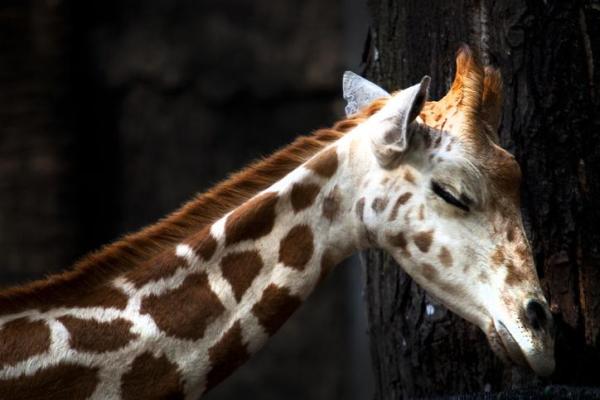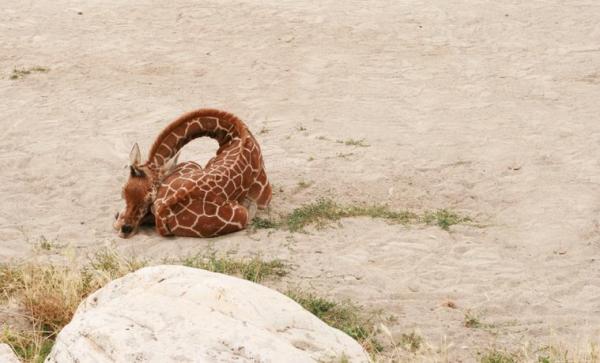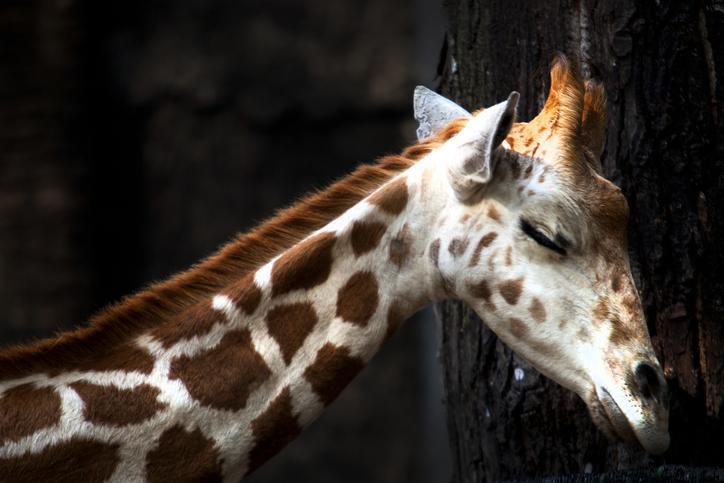Do Giraffes Sleep Standing Up?


Have you ever seen a giraffe sleeping? Probably not. You might have wondered how an animal with such a long neck can sleep comfortably. You have probably asked yourself, “Do giraffes sleep standing up or lying down?” As you might have guessed, a giraffe's sleeping habits are very different from other animals.
In this AnimalWised article we answer the question how do giraffes sleep? and explain how much time giraffes spend resting and why. We also share some other interesting facts about this curious and well-loved animal. Keep reading to find out more about the giraffe's sleeping habits.
Giraffe characteristics
The giraffe (Giraffa camelopardalis) is a quadruped mammal known for height, with its long legs and characteristically long neck. In fact, it is the tallest living animal in the world. Here are some of the most important facts about giraffes:
- Habitat: Giraffes are native to the African continent, where they inhabit areas with abundant grass, or savannas and hot plains like the Serengeti. They are herbivorous animals, and feed on leaves that they strip from the tops of trees. If you are interested, here is some more information about the giraffe's habitat and distribution.
- Height and weight: Male giraffes are taller and heavier than females: they can be up to 5.8 meters (19 feet) tall and weigh around 1,900 kilos (~2600 lbs). Female giraffes are usually 4-5 meters (14-16 feet) tall and weigh around 823 kilos (~1800 lbs).
- Coat: Giraffe's have patterned coats, with a lighter background covered in dark brown or tan patches. The color of a giraffe's coat varies with age and depending on their health.
- Tongue: A giraffe's tongue is long and black, measuring up to 50 cm (21 inches). This helps the giraffe access leaves with ease, and even clean its ears.
- Reproduction: The gestation period in a giraffe is 15 months. After this time, the female giraffe gives birth to a single calf weighing 60 kilos (132 lbs). Baby giraffes have the ability to run just a few hours after birth.
- Behavior: Giraffes are sociable animals, and they usually travel in groups of varying size to protect themselves from predators.
- Predators: The giraffe's main predators are lions, leopards, hyenas and crocodiles. However, giraffes have a powerful kick, so predators tend to be cautious when attacking them. Humans also present a threat to their survival, as giraffes are often victims of poaching for their skin, meat and tail.
Unfortunately, poaching and habitat loss have led to giraffe numbers dropping by 40% in the last three decades and they are categorized as a vulnerable species in the IUCN Red List[1].

Types of giraffes
Giraffa camelopardalis is the only species of giraffe that exists. There are 8 recognized subspecies, though they are physically very similar to each other. All of the subspecies are native to the African continent.
- Rothschild's giraffe (Giraffa camelopardalis rothschildi)
- West African Giraffe (Giraffa camelopardalis peralta)
- Masai Giraffe (Giraffa camelopardalis tippelskirchi)
- Reticulated Giraffe (Giraffa camelopardalis reticulata)
- Kordofan Giraffe (Giraffa camelopardalis antiquorum)
- Angolan Giraffe (Giraffa camelopardalis angolensis)
- Thornicroft's Giraffe (Giraffa camelopardalis thornicrofti)
- Nubian Giraffe (Giraffa camelopardalis camelopardalis)
Of these, the Rothschild's and West African subspecies of giraffe are classified as endangered in the IUCN Red List[2][3].

How long do giraffes sleep?
Before talking about how giraffes sleep, we need to understand how much time they spend sleeping. Like most other animals, giraffes need to rest to recover energy and develop normally. However, not all animals share the same sleeping habits. Each species has evolved to sleep in the most productive and least risky way possible.
Giraffes are among the animals that sleep the least, not only because they spend very little time sleeping but also because of their inability to achieve deep sleep. In total, they rest for only about 1-2 hours a day, but not all at once. These two hours are usually spread out throughout the day in the form of 2 to 10 minute naps. Adult giraffes in the wild sleep as little as half an hour a day. Baby giraffes need to sleep more than adults, and usually spend longer continuous stretches of time sleeping.
Why do giraffes sleep so little?
In the wild, giraffes cannot sleep for long stretches of time because they live in open savannas. Sleeping makes them vulnerable to predators. Although they are fast runners, it takes them a while stand up, given their long legs and body structure. So short naps, rather than a long night's sleep, can help them avoid predators better.
Young giraffes in the wild can sleep for longer stretches, because the adults keep a look out and protect them from predators. In captivity, giraffes need to be less alert and therefore tend to sleep more - sometimes up to 4.5 hours, and usually at night.
Another theory suggests that giraffes don't sleep much because of their eating habits, and the fact that they spend a lot of their day ruminating. This involves regurgitating food and and chewing it again, which takes up a large part of their day, and for which they have to remain standing up. In fact, rumination is associated with a relaxed state. A giraffes can doze off, squeezing in short naps, while still chewing.
If you are curious about the sleeping habits of other animals check out these articles:
How do giraffes sleep?
We've discussed the characteristics of giraffes, the different subspecies that exist and their sleeping habits. Now, for the big question: how exactly do giraffes sleep? Because of their unusual body structure, giraffes have developed unique postures for sleeping and resting.
Do giraffes sleep standing up or sitting down?
Giraffes usually sleep in short naps, and adults generally sleep standing up. This way, they can react quickly in case of danger. Lying down makes it harder for them to run away or kick a predator, increasing their chances of falling prey to to an attack. When a giraffe sleep standing up, its neck usually relaxes and and its head may tilt forward. This posture is associated with light sleep in giraffes.
Giraffes can also sleep sitting down, in what is called a recumbent posture. They first sit down with their legs folded under their bodies. When sleeping, a giraffe either sits with its head tilted forward, or with its neck bent backwards and head resting on its back, hindquarters or the ground. This swan-like sleeping posture is most common among young giraffes and is associated with deeper sleep. Adult giraffes may occasionally sleep in this posture as well, though only for very short periods of time.
Sleeping standing up is not exclusive to giraffes. Other species that run similar risks of being attacked, or are also ruminants, share this habit. Donkeys, cows, sheep and horses are some examples.

If you want to read similar articles to Do Giraffes Sleep Standing Up?, we recommend you visit our Facts about the animal kingdom category.
1. Muller, Z., et. al. (2018). Giraffa camelopardalis (amended version of 2016 assessment). The IUCN Red List of Threatened Species 2018. eT9194A136266699.
https://www.iucnredlist.org/species/9194/136266699
2. Fennessey, S. et al. (2018). Giraffa camelopardalis ssp rothschildi. The IUCN Red List of Threatened Species 2018. eT174469A51140829.
https://www.iucnredlist.org/species/174469/51140829
3. Fennessey, J., Marais, A., and Tutchings, A. (2018). Giraffa camelopardalis ssp peralta. The IUCN Red List of Threatened Species 2018. eT136913A51140803.
https://www.iucnredlist.org/species/136913/51140803
- Seeber, P., Ciofolo, I., Ganswindt, A. 2012. Behavioural inventory of the giraffe (Giraffa camelopardalis). BMC Research Notes, 5:650.
https://www.ncbi.nlm.nih.gov/pmc/articles/PMC3599642/ - Despard Estes, R. 1991. Introduction to Ruminants. The Behavior Guide to African Mammals. University of California Press.








